Designing Dynamical Learning Environments for Simulation: Micro-Worlds & Applets on the World Wide Web
dr. ir. Rik Min
researcher / designer / problem solver
Faculty of Educational Science and Technology (EDTE), University of Twente (UT)
Postbus 217; 7500 AE Enschede, The Netherlands. E-mail: ...@...utwente.nl
http://....edte.utwente.nl/min
Some theories
about
parallelism and 'parallel instruction'
(in relation to cognitive load)
1
Principle of split attention / parallelism:
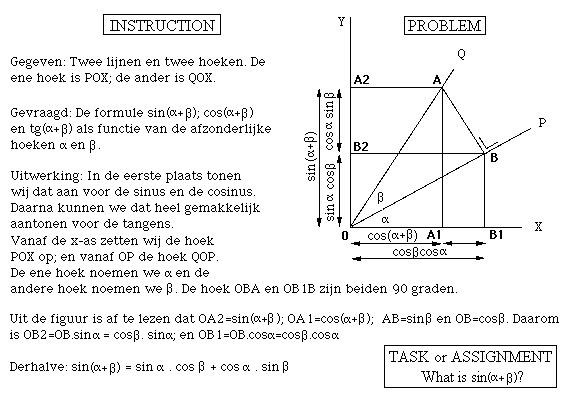
Two different parts on this screen: region A and region B.
2
Example of a task where the attention is split in a problem and an instruction (A and B):
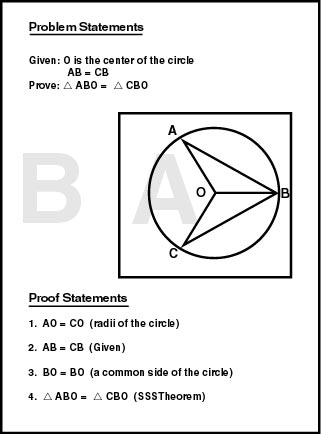
An example of split attention in a math-task accoording Mousavi, Low, & Sweller (1995).
More examples about split attention and parallellism (Min) (in accordance). (extra)
3
Principle of parallelism:

The principle of parallelism.
- A: the mean attention area, a working-, doing- or problem solving
environment (width=a);
- B: the instruction, information, task or reference area (parallel) (width=b);
- x: the distance between A and B.
The research question is: "What is the optimum of x?"
- Situation 1: x > 1/2 a + 1/2 b --> first order parallelism
- Situation 2: x < 1/2 a + 1/2 b --> second order parallelism (overlap)
- Situation 3: x = 0 --> no parallelism; so you have a serial medium
4
Parallel flows or views: principle of a complex learning environment with more than 9 information flows parallel.

The use of all the perception channals of the user: eyes, ears, etc.
(comination of first and second order parallelism)
5
Solution: two windows on one screen:
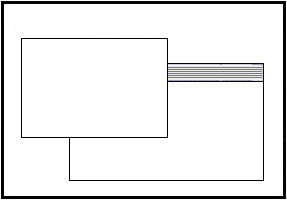
With extra window; the surface is bigger then 100%
(2 order parallelism)
x varies between 1 to 30 cm or more.
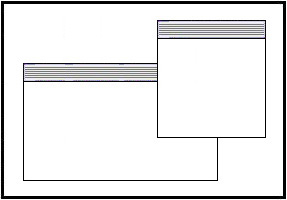
With extra window; the surface is bigger then 100%
(2 order parallelism)
x varies between 1 to 30 cm or more.
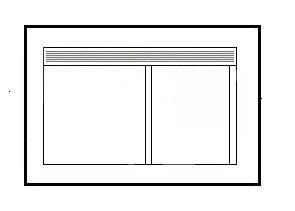
With 2 or more viewports; the surface is 100%
(1 order parallelism)
x varies between 1 to 40 cm or more.
Examples:
from everyday life (photo's)
6
Solution: one, long web-page on a screen:
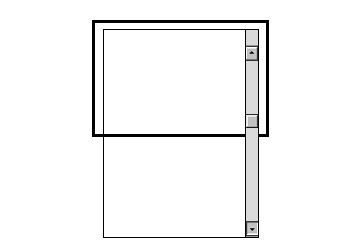
A big web-page.
(The surface is bigger then 100%.)
We call that: virtual parallelism.
X varies between 1 to 30 cm or more.
Example:
5 experiments (with a practical tasks)
Example:
5 experiments (with a theoretical tasks)
7
Linear media (serial media)

"What you have seen (in de past); you have forgotten (now)."
Our short time memory is the problem in computer-based problem solving (with a small screen).
8
Problem with frame-by-frame or screen-by-screen: your memory

On top: frames every 1/25 second (as in movies).
Design problem: If the frame and the content of the frame is gone: then the user want to see the information for using them. In problem-solving you need parallellism and the sequences must be controled by the user.
9
Four important theories as good references and introduction to the PI theory
- Paivio, 1990: the dual-code theory
- Chandler & Sweller, 1991: the split-attention theory
- Sweller, 1990 - 1994: the cognitive load theory
- Mayer, 1995: the multimedia learning theory
- Min, 1992 - 1994: the parallel instruction theory
10
The concept of the PI-theory:
The PI-theory in four points: So far it is assumed that the usefulness of parallelism in open do environments is due to:
- 1. the user's limited short term memory as regards details or loose components; because the monitor always wipes out the image contents partly or entirely when the next image is shown;
- 2. the user wants to, must and can compare; by comparing things from the past physically to things of the present;
- 3. the user wants to gain insight into cause/result-relations (on the screen); through repeated verification and compare (with other things);
- 4. the user wants to create his own frame of reference and should be able to do so; by putting things that pass by on the screen side by side (by means of windows) and comparing them.
If you don't give attention to this points or this theory in the design of your multimedial, hypermedial, web-based software product, your product will failed.
11
The concept of parallelism in our learning environments
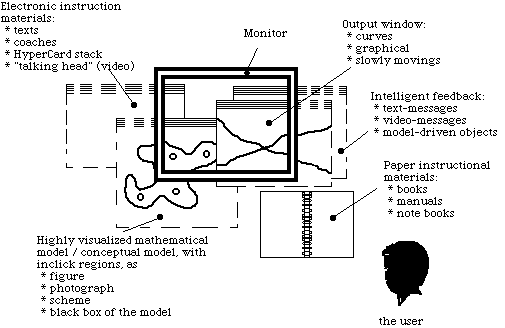
The user sees a lot of information from a lot of areas (Min, 19xx).
12
The concept of our parallel instruction (as input)
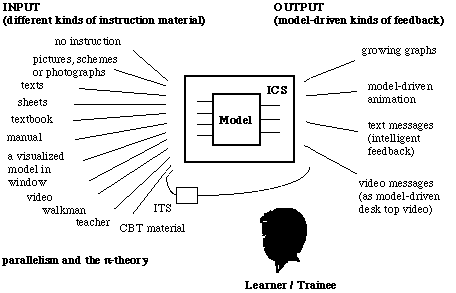
The user gets a lot of information from a lot of media (Min, 19xx). All this parallel instruction is input; and necessary for starting the learning sessions. (The output is for continuing the learning sessions).
13
More information
== more about parallellism and the PI theory ==
== parallellism and the PI theory ==
14
xxxx
xxxx a summery of one of the next papers in relation to the two articles of Min (1992) (1994); xxx to the relations to parallelism and the parallel instruction theory (of Min).
- Benshoof, L.A., en S. Hooper (1993). The effectes of single- and multiple-Window Presentation on
Archievements During Computer-Based Instruction'. J. of Comp. Based Inst. vol. 20, no. 4, p. 113-117.
Benshoof and Hooper investigated the effects of using single- and multiple-window presentations on archievement and window-use.
- Mayer, R. E. and R. Moreno (2000). A split attention Effect in multimedia Learning: Evidence for Dual Processing Systems in Working Memory. J. of Educ. Psych., Vol. 90, no. 2, p. 312-320.
Mayer and Moreno about multimedia learning and modality principles. Dual code theory? Cognitive principles of multimedia design: split attention effect and other effects.
- Sweller, J., van Merrienboer, J. J. G., and Paas, F. G. W. C. (1998). Cognitive Architecture and Instructional Design. Educational Psychological Review, Vol. 10, No. 3, pp. 251-296.
The cognitive load theory assumes a limited capicity working memory that includes partially independent subcomponents to deal with auditory/verbal material and visual/2- of 3-dimensional information.
- Moreno, R., and R.E. Mayer (1999). Cognitive Principles of Multimedia Learning: the role of modality and Cogniguity. J. of Educ. Psychology, vol. 91, no. 2. pp. 358-368.
Split attention effect; multimedia learning.
- Paivio, A., (1986). Mental representation: A dual coding approach. Oxford England. Oxford University Press.
The article about the Dual Code Theory. Text and visual information (parallel). Integrating texts and visuals.
- Sweller, J. (1994). Cognitive Load Theory. Learning & Instruction. vol. 4; pp 295-312.
The cognitive load theory
- Mousavi, S. Y., Low, R., & Sweller, J. (1995). Reducing cognitive load by mixing auditory and visual
presentation modes. Journal of Educational Psychology, vol. 87, pp. 319-334.
The use of partly visual mode of presentation for geometry worked examples. The logic was based on the split attention effect and the effect of presentation modality on working memory. Split attention between multiple sources of information.
- Moreno, R., and R.E. Mayer (1999). Multimedia supported Metaphors for meaning Making in Mathematics. Cognition & Instruction, vol. 17, no. 3, pp. 215-248.
Mayer and Moreno (1999) about hih-archieving students and low-archieving students.
- Diehl & Mills (1995). The effects of interaction with the device described by procedural text on recall,
true/falls, and task performance. Memory & Cognition.
Diehl & Mills about "information available while reading leads to differential development of representations in memory, which, in turn, causes differences in perfomance on various measures". A task is: 'read and do' or 'read and see experimenter do' or 'read and imagine' or 'read and see' or 'read only'.
- Ainsworth, S. (1999).
The functions of multiple representations. Computers and Education, 33, 131-152.
About multiple representations of the same problem or the same instruction.
Enschede, 2002; updated: jan. 15, 2003. Gerestaureerd in 2020.











